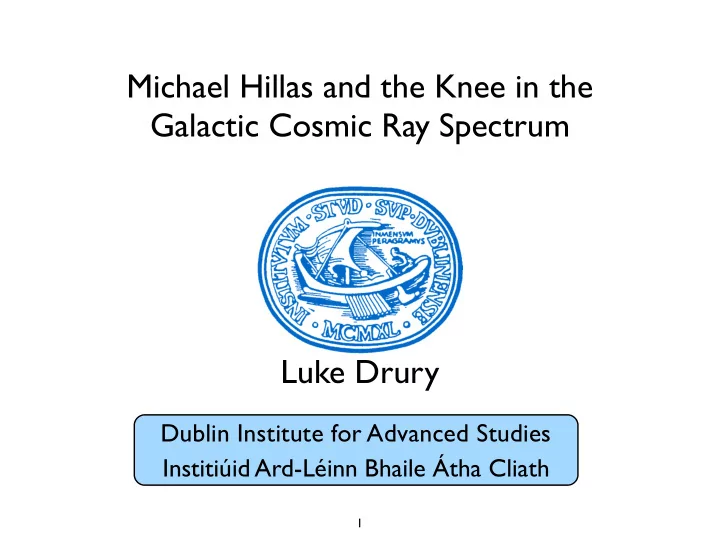

Michael Hillas and the Knee in the Galactic Cosmic Ray Spectrum Luke Drury Dublin Institute for Advanced Studies Institiúid Ard-Léinn Bhaile Átha Cliath 1
Michael mainly worked on air showers and thus mostly discussed particles with energies above the “knee” energy of about 3PeV. However as a good theorist he was well aware of the importance of lower energy particles and in particular he worried about the origin of the well know feature in the all-particle energy spectrum at 3PeV, the so-called “knee”. Published a series of papers throughout his long career. 2
At least 8 publications over 27 years 3
First paper is from the Kyoto ICRC in 1979 4
Michael’s compilation of the then available data 5
Brave attempt Gets EAS data to fit the Grigorov data well by rescaling the Chacaltaya data. Tries to use electron and muon EAS data to get some handle on the composition. Concludes that the proton knee is at a higher rigidity than for the heavy nuclei, thus not a magnetic trapping (rigidity) effect! Suggests photo-disintegration as a possibility, but needs EUV or soft X-ray photons and unreasonable parameters. 6
Paris ICRC 1981 - a heavy knee! 7
Illustrates how difficult it is to extract compositional information from air shower data - still a problem today! Best current data does indicate that the knee is quite proton-poor, so the Paris paper is quite prescient. Interestingly no speculation about the cause of the knee in the Paris paper. 8
Three years later in 1984 at 4th Moriond meeting 9
Suggests that anisotropy data can be used as a proxy for the energy dependence of the escape time. Considers possibility that the knee is just the result of a more rapid escape from the galaxy setting in. If so need sources producing a single power-law all the way up to 10EeV - introduces famous Hillas plot. Notes however that this model has clear implications for composition which do not seem to fit the EAS properties. 10
11
The “Hillas plot” shown at Moriond 12
However… In conclusions… 13
Vulcano workshop, 1988 14
Includes a reference to a mysterious O’Drury who appears to have worked on acceleration theory! Points out all the problems identified earlier. Speculates about the possibility of a new source related to the then current claims of UHE gamma- rays from some binary neutron star systems (Cyg X-3, Her X-1, Vela X-1) Also considers possible role of a Galactic wind terminal shock 15
16
Revisited ten years later in Vulcano 1998 17
18
19
20
Note assumption of softer proton spectra - long before Pamela and AMS-02 results! 21
Final paper, published 2006, given in 2005 22
Essentially what most of us believe now…. 23
24
25
What can we learn from Michael’s long attempt to understand the knee? Always data-driven with no cherry-picking - used all available evidence. Prepared to consider exotic ideas and non- standard models. Persistence - he kept returning to this problem and refining his ideas all through his life. A model of how science should be conducted, but rarely is! 26
Recommend
More recommend